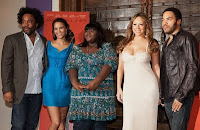
As the movie Precious ascends to the top of the movie rankings this weekend, much will be said about the marketing power of Oprah and the film production wizardry of Tyler Perry. While both lent their names and followings to the promotional effort, the producing couple Sarah Siegel-Magness and her husband Gary Magness deserve equal credit as they acquired the rights to the novel PUSH from author Sapphire. It was the Magnesses who conducted the casting that landed Gabourey Sidibe, believed in director Lee Daniels and got the movie to Sundance where they made a deal with Lionsgate (5mil) who brought in Perry. I am not naive enough to say that having Oprah and Perry out in front of this movie doesn't enhance the profile or insure good draws at the box office, but I am for fair coverage and acutally find it interesting that at the heart of this gritty story about abuse in a black family, you have a white couple from Colorado believing in it enough to believe in Lee Daniels enough to sink the money to get it made. Having read this story, I will be happy for Mr. Perry and Ms Winfrey should Oscars come out of this film, but I'll also be looking to see how the Magnesses bask in their moment of glory on the dais.
Click here for the full story

